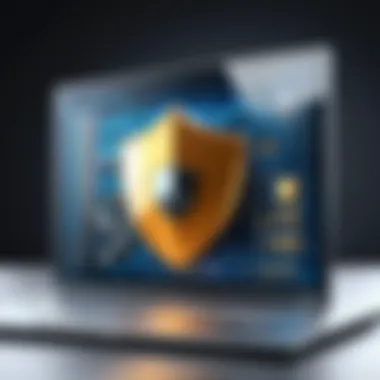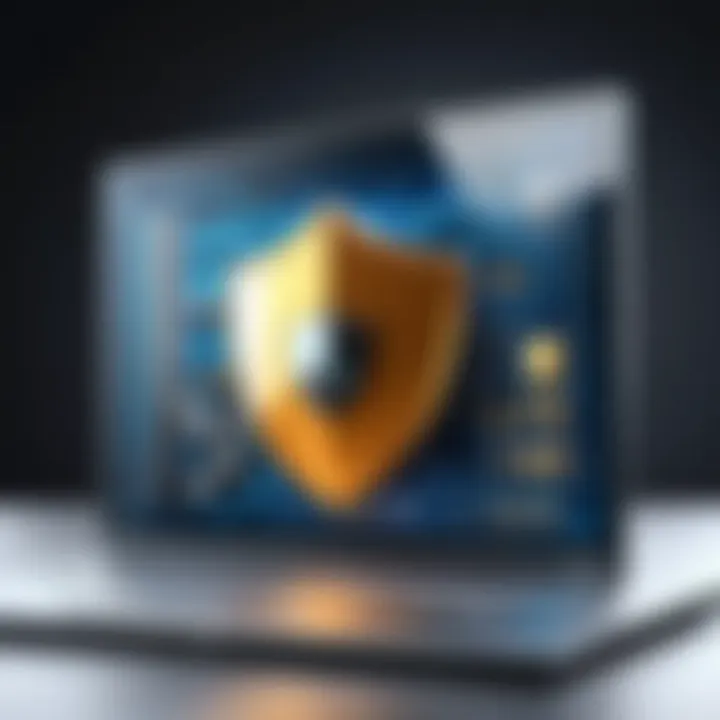Why New Computers Absolutely Need Antivirus Software


Intro
In today's digital age, the conversation around computer security is more relevant than ever. As technology evolves rapidly, so do the threats that can jeopardize our systems and personal data. New computers often come equipped with a variety of security measures, yet the question persists: Is antivirus software necessary? Understanding the intricate dance between modern operating systems, user habits, and cyber threats is essential for anyone diving into the world of computers.
This piece lays the groundwork for discussing the necessity of antivirus solutions in the context of these complexities. By examining current cybersecurity threats, emerging trends in cyber attacks, and the effectiveness of antivirus solutions, readers will gain insights into making informed choices for their new devices. We’ll explore the interplay between security features built into operating systems and the external threats lurking online, allowing users to navigate their cybersecurity landscape wisely.
Cybersecurity Threats and Trends
Notable cybersecurity threats in the digital landscape
One cannot ignore the increasingly sophisticated threats present in today’s digital environment. Ransomware, for instance, has become a notorious figure, targeting businesses and individuals alike, locking access to essential files until a ransom is paid.
Then there's phishing, which is akin to the digital equivalent of fishing with bait. Attackers craft emails that appear legitimate, luring victims into clicking malicious links or disclosing personal information.
Emerging trends in cyber attacks and vulnerabilities
As technology advances, so do the tactics of cybercriminals. AI and machine learning are no longer just buzzwords; they are now tools leveraged by attackers to automate and enhance their operations. This escalation has led to the emergence of highly targeted spear phishing attacks, making them even more dangerous than the traditional methods.
Moreover, with the rise of IoT devices, the attack surface has broadened. Each connected device can serve as an entry point, enabling hackers to penetrate networks more easily than before.
Impact of cyber threats on individuals and businesses
The repercussions of these threats can be severe. For individuals, cyber attacks could mean personal data breaches, identity theft, or financial loss. For businesses, the stakes are even higher. The costs associated with data breaches can escalate quickly, not only from immediate financial losses but also from long-term reputational damage.
"Every device you connect, opens the door just a crack for a potential attack; don’t give them an invitation."
Best Practices for Cybersecurity
Importance of strong password management
A weak password is like leaving your front door wide open for intruders. Emphasizing the necessity of strong passwords is paramount. Using a blend of uppercase letters, numbers, and symbols can enhance security significantly.
Implementing multi-factor authentication for enhanced security
Adding an extra layer with multi-factor authentication (MFA) can also be a game changer. Even if credentials are compromised, MFA can thwart unauthorized access, ensuring only the rightful account owner can reach sensitive information.
Regular software updates and patches for protection
Keeping software up-to-date helps seal vulnerabilities. When companies release updates or patches, they usually address weaknesses that could be exploited. Ignoring them is like leaving a backdoor open.
Secure online browsing habits and email practices
Practicing secure browsing habits is essential. Be cautious of what you click on and where you enter your personal information. Checking URLs and avoiding unsecure sites can significantly reduce risks.
Privacy and Data Protection
Importance of data encryption for privacy
Data encryption acts as a protective barrier, rendering your data useless to any unauthorized third party who might access it. Encrypting sensitive files ensures that your information remains private, even if it falls into the wrong hands.
Risks associated with sharing personal information online
Being too generous with personal information can be dangerous. Oversharing can lead to identity theft and other privacy breaches. Reviewing privacy settings on social media and other platforms can help minimize exposure.
Strategies for safeguarding sensitive data and personal details
Strategies can include using secure cloud services, employing encrypted messaging apps, and understanding your online footprint. Keeping your digital persona in check is just as crucial as maintaining your physical one.
Security Technologies and Tools
Overview of key cybersecurity tools and software
The raw functionality behind cybersecurity tools can make a significant difference. From antivirus software like Bitdefender to firewalls that act as barriers, these tools are essential for robust protection.
Benefits of using antivirus programs and firewalls
Antivirus programs scan for and eliminate threats before they wreak havoc. A firewall, on the other hand, restricts unauthorized connections, serving as a digital bouncer for your network.
Application of Virtual Private Networks (VPNs) for secure data transmission
When it comes to securely transmitting data over the internet, VPNs are indispensable. They create a secure tunnel between your device and the internet, making it nearly impossible for outsiders to intercept your data.


Cybersecurity Awareness and Education
Educating individuals on recognizing phishing attempts
Recognizing phishing attempts is crucial. Education can help individuals spot red flags in emails and understand the tactics used by cybercriminals.
Promoting cybersecurity awareness in the digital age
Awareness goes beyond just understanding threats; it's about fostering a culture where cybersecurity is prioritized. This is especially crucial in settings like workplaces where multiple devices are interconnected.
Resources for learning about cybersecurity fundamentals
For those looking to deepen their understanding, resources such as online courses from platforms like Coursera or articles from reputable sites like Britannica can prove invaluable.
Navigating the complicated world of cybersecurity is not a straightforward task, especially with the emergence of new threats daily. Understanding these nuances can empower individuals and organizations alike to make informed decisions about deploying antivirus solutions on their new computers.
Understanding Cybersecurity Threats
In today's rapidly evolving digital landscape, understanding cybersecurity threats is akin to having a map in a dense forest—it shows you where dangers lurk and helps you navigate effectively. Security risks abound, and being oblivious to them can be like walking a tightrope without a safety net. New computer owners, in particular, need to be vigilant as they might not yet have a fortress of knowledge around the potential hazards awaiting them.
Every device connected to the internet faces threats that can compromise sensitive data and wreak havoc on systems. Knowing the types of threats—such as malware variants, phishing scams, and other malicious activities—gives users the upper hand. It’s about arming oneself with the right information so they can make informed decisions about protective measures.
Overview of Modern Threats
Modern threats are not just common gardening tools for cybercriminals; they are advanced weaponry designed to exploit weaknesses. The landscape is vast, ranging from well-known contagions like ransomware to sophisticated schemes that employ social engineering. New computers, often equipped with the latest technology, are not exempt from these attacks. In fact, their shiny facades might attract more attention from those looking to do harm.
Moreover, as technology advances, so do the tactics of cyber adversaries. Understanding these modern threats helps in recognizing the critical impact they can have—both individually and collectively on networks, systems, and users. This is especially crucial for individuals who may not realize the importance of robust cybersecurity in daily operations and the reliance on personal devices for everything from banking to shopping.
Types of Malware
Diving deeper, malware is the primary antagonist in the tale of cybersecurity. It comes in various forms—each with its own agenda and modus operandi. Let's explore each type:
Viruses
Viruses are the notorious bad apples of the malware world. They infiltrate systems through attachments or infected software, then replicate themselves, embedding in other files across the device. The key characteristic here is their self-replicating nature, which allows them to spread like wildfire.
Viruses are often likened to a common cold; they can be mild or devastating. They often come disguised in legitimate programs, making them a hidden threat. While they can be caught and eliminated through effective antivirus solutions, their existence serves as a reminder of why being proactive with security is indispensable.
Worms
Worms, on the other hand, are unique because they can spread independently. Unlike viruses, they don’t need a host file to propagate; they often exploit network vulnerabilities to infect other systems. This characteristic drastically amplifies their potential impact.
For new computer users, worms can be a concerning threat. They may go unnoticed until they've already spread across the network. This makes awareness critical, as detecting and neutralizing worms can require significant effort and advanced tools.
Trojan Horses
Trojan horses are deceitful in nature. They masquerade as harmless applications while delivering payloads malicious intentions, such as backdoors or downloading additional malware. Their key feature is camouflage; they often appear to be legitimate software, which can trick even the most cautious users.
Trojan horses’ ability to blend in poses a significant challenge in cybersecurity defense for new computer owners. It's important to scrutinize software sources before downloads, as one lapse in judgment could lead to dangerous consequences.
Spyware
Spyware stealthily monitors user activity and collects personal information without consent. This type of malware is particularly invasive, often recording keystrokes or tracking browsing habits. The defining characteristic of spyware is its ability to operate unnoticed, gathering data like a hidden camera in the room.
The implications for new computer users can be dire, as they might unwittingly expose sensitive data or financial information. Without adequate security measures, spyware can thrive, turning a private device into a goldmine for cyber criminals.
Adware
Adware is a more benign-looking type of malware. It typically inundates users with unwanted ads or pop-ups, often slowing down system performance. What distinguishes adware is that it generally profits from misleading users into clicking on ads, sometimes leading to more serious problems like malware installation.
While often perceived as a nuisance, the persistence of adware can distract users and expose them to more dangerous threats. For new computer owners, learning to recognize adware and how to mitigate its effects is vital to maintaining a smooth and secure browsing experience.
Emerging Threats in
Looking forward, 2023 is poised to bring along its share of threats as cybercriminals continue to adapt and reinvent their approaches. New trends are emerging, such as state-sponsored hacking or the rise of cryptojacking, where hackers hijack a computer's resources to mine cryptocurrencies. As technology trends shift, so do strategies in malware creation and deployment, forcing users to stay constantly vigilant.
In this environment, new computer owners must remain informed about the evolving threat landscape to adequately protect themselves and their data. It's not just about installing antivirus software; understanding why it’s necessary and how it fits into a broader strategy for cybersecurity hygiene is the key takeaway.
The Role of Operating Systems
Understanding the role of operating systems is critical when discussing antivirus software for new computers. An operating system (OS) serves as the backbone of a computer, facilitating interaction between hardware and software components. A well-designed OS incorporates a variety of security features that can help combat threats, thereby reducing the dependence on third-party antivirus solutions. However, the effectiveness of these security measures relies heavily on how users apply them.
Built-in Security Features


Operating systems like Windows, MacOS, and Linux come equipped with built-in security features that aim to protect the user from a range of cybersecurity threats.
Windows Defender
Windows Defender, now known as Microsoft Defender, is a free antivirus program bundled into Windows 10 and later versions. One distinct aspect of Windows Defender is its integration into the operating system, making it easy to use and ensuring constant protection without the need for additional software. Its real-time protection shields users from threats, and the regular updates from Microsoft help to enhance its effectiveness.
A key characteristic of Windows Defender is its ability to perform both antivirus scanning and malware detection simultaneously. This dual function gives it a notable edge. Furthermore, it offers features such as firewall protections and parental controls, which can be particularly appealing for families looking to maintain a safer computing environment. However, while it's a solid choice for those who want basic protection without extra cost, some users argue that its detection rates aren't as robust as certain paid solutions.
MacOS Security Protocols
MacOS focuses heavily on security through its unique security protocols, including Gatekeeper and XProtect. Gatekeeper prevents untrusted applications from being installed, while XProtect can automatically spot malware in downloaded files. This proactive approach not only protects users but also ensures that only verified applications can run, creating a more secure user experience.
MacOS's built-in security is known for its less intrusive nature compared to traditional antivirus solutions, which may be one reason it’s favored among users who dislike constant alerts. Yet, even with these safeguards, MacOS users are not invincible. Cyber threats are evolving, and there are cases of malware targeting Apple systems, making it necessary for users to remain vigilant.
Linux Security Models
Linux is often touted as a safer alternative for tech-savvy users, primarily due to its permission-based security model. This framework means that users have restricted access until permissions are given, essentially fortifying the system against unauthorized access. In addition, the open-source nature of Linux allows for rapid updates and community-driven security improvements.
One notable feature of Linux security is SELinux (Security-Enhanced Linux), which provides a flexible access control mechanism that can greatly reduce vulnerability. The characteristic of having multiple distributions allows users to choose specialized systems with inherent security measures tailored to specific needs. However, despite these advantages, the lack of user-friendly interfaces for managing security can pose a challenge for average users.
Update Policies and Their Impact
Regular updates for both operating systems and security features play a vital role in maintaining a secure environment. When manufacturers release patches, they often address vulnerabilities that could be exploited. Staying updated can help close the gap that malware might use to infiltrate a system.
Furthermore, user behavior regarding updates is a critical factor. Some users opt for delayed updates or even ignore prompts altogether, leaving their systems exposed. Thus, it is essential for users to understand the importance of not only having antivirus measures in place but also ensuring their operating systems receive timely updates.
User Awareness Regarding OS Security
User awareness around operating system security cannot be overstated. Knowledge about how built-in features work and the significance of regular updates empowers users to take active roles in their cybersecurity. Those who are informed can better navigate potential pitfalls, recognizing when to engage additional protection measures or to rely solely on their OS’s capabilities. Ultimately, fostering a culture of security-mindedness is just as vital as the operating system's technological safeguards.
Evaluating Antivirus Solutions
In the ever-evolving landscape of cybersecurity, the task of evaluating antivirus solutions becomes paramount for anyone setting up a new computer. It’s not just a matter of picking a program off the shelf; rather, it’s about understanding how these solutions work and what they protect against. By diving deep into this topic, users can discern the best fit for their unique needs, striking a balance between robust protection and usability.
To begin with, there’s an array of options on the market, each boasting different features and capabilities. This section aims to dissect various types of antivirus software, assessing their effectiveness, advantages, and considerations when making a choice. It’s crucial to navigate through this realm thoughtfully, weighing factors like cost, functionality, and the evolving nature of threats.
Types of Antivirus Software
No matter if you're a tech-savvy professional or just someone who’s trying to make sense of these digital shields, understanding the types of antivirus software is essential. The offerings generally fall into three broad categories: free vs paid solutions, cloud-based antivirus, and traditional antivirus packages.
Free vs Paid Solutions
When pondering over free vs paid solutions, one must consider the trade-offs involved. On one hand, free antivirus software can be an appealing option for those on a tight budget. They often provide basic protection against common threats. However, these free options sometimes come with limitations—like fewer features and possibly slower customer support. Additionally, many free programs rely on ad-supported models, which can be annoying and potentially detrimental to user experience.
On the other hand, paid antivirus solutions often come loaded with advanced features such as real-time protection, comprehensive scan options, and dedicated customer support. The investment in paid software can pay off by potentially preventing significant financial losses related to data breaches. Not to mention the peace of mind that comes with knowing your new computer is better defended against a broader array of risks.
"Investing in good antivirus software is like taking out insurance for your digital life."
Cloud-Based Antivirus
Next up is cloud-based antivirus, which has been gaining traction in recent years. The hallmark of these solutions is their ability to store data and run scans on remote servers rather than solely on your local machine. This can lead to quicker updates and a lighter load on your system’s resources, making it a favorable choice for many tech-savvy users.
Most importantly, such software can utilize vast amounts of data collected from countless users to detect emerging threats in real-time, making it quite a formidable option against novel attack vectors. However, relying solely on cloud-based services means that users need a stable internet connection, which can be a drawback in certain scenarios.
Traditional Antivirus Packages
Lastly, we have traditional antivirus packages. These are the stalwarts of the industry. They often come as software that you install directly onto your machine, offering an all-in-one solution that’s individualistic and straightforward. Most traditional packages boast features like scheduled scans, in-depth system analyses, and customizable settings.
However, there’s an ongoing debate about whether traditional packages offer the protection they promise, especially as new malware techniques emerge. They can sometimes eat away at system resources or become outdated if users don't stay vigilant with updates—hence the necessity of maintaining user awareness.
In summary, the process of evaluating antivirus solutions is not merely about picking the best-selling software; it demands a nuanced understanding of your specific needs and any potential vulnerabilities your new computer might face.
User Behavior and Cyber Hygiene
In the landscape of cybersecurity, user behavior plays a pivotal role. The manner in which users interact with their devices can significantly influence the overall security posture of their systems. Cyber hygiene, essentially the practice of maintaining good habits and being vigilant while using technology, is foundational in preventing security breaches. A well-informed user can often be the last line of defense against cyber threats, even when robust antivirus software is in place.
Safe Browsing Practices
Embracing safe browsing practices is crucial in today's digital age. Users should become cognizant of what they click on, as seemingly harmless links can lead to malicious sites designed to extract information or install malware.
- Use Secure Connections: Always look for HTTPS in web addresses. A padlock icon often indicates a secure connection, giving a bit more confidence about inputting personal data.
- Avoid Public Wi-Fi: When you’re connected to a public network, your information is more vulnerable. It's wise to use a Virtual Private Network (VPN) to encrypt the data being transmitted.
- Think Before You Click: Many cyber-intrusions begin with a click. Be wary of unusual pop-ups and ads that claim you’ve won something—more often than not, they’re ploys to lure unsuspecting users into downloading harmful software.
Recognizing Phishing Scams
Phishing scams have become increasingly sophisticated, often mirroring legitimate sources so closely that users might not spot the fraud until it’s too late. Recognizing these threats is essential for anyone, especially those who manage sensitive information.


- Email Scrutiny: Always scrutinize the sender’s address, as phishing emails may come from slight variations of legitimate addresses. For instance, look for missed characters or domains that don’t match.
- Urgent Calls to Action: Be cautious of emails urging immediate action, like verifying account information or resetting passwords. Legitimate organizations rarely ask for sensitive information through email.
- Hover Over Links: Before clicking any hyperlinks in emails, hover over them to see the actual destination. If it looks suspicious, don't risk it.
The Importance of Regular Updates
One of the simplest yet often overlooked aspects of cyber hygiene is the habit of regular updates. Updates to software and operating systems serve multiple purposes, most notably enhancing security and performance.
- Patch Vulnerabilities: Software updates often fix known vulnerabilities that could be exploited by cybercriminals. Keeping software up to date is akin to putting the locks on your doors; without them, you're more susceptible to unwanted access.
- Smart Device Management: Ensure that all smart devices connected to your network—like IoT devices—are updated too. Many users forget these devices when updating their primary systems, leaving small openings for exploits.
- Consistency is Key: Set reminders to check for updates regularly, or enable automatic updates when possible. Routine maintenance can save a lot of grief in the long run.
"Cyber hygiene is vital; it’s not just about having security measures in place, but also about how you use technology that keeps you safe."
In sum, practicing cybersecurity hygiene through safe browsing, recognizing phishing attempts, and staying current with updates will bolster the defenses against potential threats. Remember, while antivirus software is essential, personal behavior shapes how effective those tools will be.
The Debate on Antivirus Necessity
In the maze of modern technology, the question of whether new computers need antivirus software remains a hotly contested topic. This debate is pivotal not only for tech enthusiasts but also for everyday users who might feel overwhelmed by the complexities of digital security. Understanding the necessity of antivirus software hinges on several layers—ranging from the nature of cyber threats today to the evolving capabilities of operating systems. Without diving into these facets, any discussion would be as useful as a screen door on a submarine.
Arguments for Antivirus Installation
Advocates for installing antivirus software often present a multitude of compelling reasons. First and foremost is the reality of the cyber threat landscape. New computers come equipped with robust operating systems, yet they are not impervious to attacks. For example, consider a scenario where a user innocently opens an email attachment, congratulating them on winning a lottery they never entered. Without an antivirus solution, such seemingly harmless actions can lead to malicious software infiltrating their systems.
Some of the key arguments in favor of antivirus software include:
- Comprehensive Protection: Antivirus programs are designed to identify, quarantine, and eliminate a vast array of malware, ensuring a more secure experience.
- Real-Time Scanning: Many antivirus solutions offer continuous protection, scanning files and downloads as they come in, giving the user peace of mind.
- User-Friendly Interfaces: Modern antivirus software is often built with accessibility in mind, making it simpler for users to manage their digital security without diving into the technical nitty-gritty.
Research has shown that unprotected devices are substantially more likely to encounter issues with malware. As the world becomes increasingly interconnected, the risks grow proportionately, making antivirus software not just a protective measure but a necessary tool for maintaining security and privacy.
Counterarguments Against Antivirus Necessity
While many defend the use of antivirus software as a critical security measure, there are also strong voices expressing skepticism. Some argue that the capabilities embedded in modern operating systems and the nature of evolving threats paint a different picture. These points of view rest on several considerations, including potential drawbacks associated with relying on antivirus programs.
Key counterarguments often cited include:
- Built-in Security Features: Operating systems like Windows, MacOS, and Linux come empowered with their own security features that can shield users from a multitude of threats. For instance, Windows Defender has evolved significantly and offers robust protection against various forms of malware.
- Resource Consumption: Many antivirus solutions can be resource-heavy, potentially slowing down a new computer's performance. Users may find their devices lagging or running inefficiently due to the additional software running in the background.
- False Sense of Security: There's a risk that users, armed with antivirus software, might engage in riskier online behaviors, thinking they are invulnerable to threats. This misconception can lead to dangerous practices like skipping updates and neglecting other crucial aspects of cybersecurity hygiene.
Future of Antivirus Software
The future of antivirus software is as critical as ever in light of the rapidly evolving digital landscape. As technology strides forward, so too do the techniques employed by cybercriminals, making cybersecurity a moving target. The discussion of whether new computers necessitate antivirus software should incorporate an understanding of how these protective tools are transforming and what new features they might offer.
Recognizing the necessity of antivirus solutions in modern computing hinges on comprehending certain vital elements: advancements in protection methods, integration of artificial intelligence (AI), and the growing complexity of cyber threats. These factors collectively influence user safety and privacy, making the role of antivirus software more significant than ever.
Evolution of Malware Protection
The evolution of malware protection has been directly influenced by the increasing sophistication of cyber threats. Gone are the days when a simple antivirus program was enough to safeguard a system from a basic virus. Today's malware includes a wide range of malicious software, including ransomware, spyware, and even more advanced threats like polymorphic malware – those that can change their code to evade detection.
To keep up with these emerging threats, antivirus solutions have evolved in several ways:
- Behavioral Analysis: Instead of relying only on signature-based detection, modern antivirus solutions now employ behavioral analysis to identify suspicious activities in real-time. If a program starts acting out of line, even if it hasn't been previously identified as a threat, it can be flagged for further investigation.
- Sandboxing Techniques: Antivirus software can now execute potentially harmful programs in an isolated environment before allowing them to run on the main system. This helps to identify threats without compromising the integrity of the user's data.
- Integration of Threat Intelligence: Many antivirus programs now use data from global networks to monitor threats. This collective intelligence ensures that as soon as a new threat is detected, users across the globe can be protected promptly.
In summary, the evolution of malware protection means users are not just protected against known threats but are also safeguarded against emerging and unidentified risks.
Role of Artificial Intelligence in Cybersecurity
Artificial intelligence is fast becoming a cornerstone of cybersecurity strategies, especially in antivirus software. The integration of AI enhances several aspects of threat detection and response:
- Predictive Analysis: AI algorithms can analyze past threat data to predict upcoming cyber attacks. By understanding patterns in how malware behaves, these systems can stay one step ahead of cybercriminals.
- Automated Response: AI can help in taking immediate action when a threat is detected, such as quarantining suspicious files or alerting the user. This swift response minimizes potential damage.
- Continuous Learning: Machine learning, a subset of AI, allows antivirus solutions to learn from new threats continuously. As they encounter new malware, they adapt and improve their detection capabilities without human intervention.
"The next wave of cybersecurity technology lies in its ability to learn and adapt, making it more resilient against ever-evolving threats."
Overall, the future of antivirus software is not just about combating existing threats but anticipating and neutralizing new risks through the power of AI. For both IT professionals and everyday users, understanding this dynamic is crucial for maintaining a high level of security in their digital lives.
The End
As the digital landscape evolves, the question of whether to install antivirus software on new computers becomes paramount not just for individual users but for organizations alike. The significance of this topic is underscored by the increasing prevalence of cyber threats that exploit vulnerabilities in systems and human behaviors.
Key Takeaways for New Computer Owners
New computer owners should digest the following insights:
- Security Risks Are Evolving: Cyber threats are not one-size-fits-all. From phishing attempts to advanced malware, understanding what lurks behind your screen is essential.
- Tech Isn't Foolproof: Even the most advanced operating systems, like Windows or macOS, come with their own set of vulnerabilities. Their built-in security features are typically strong, yet they can't cover all bases.
- User Behavior Matters: A large chunk of security comes down to user practices. Simple actions like clicking dubious links can open a Pandora's box of vulnerabilities, making it crucial to couple safe online habits with antivirus protection.
- Assess Your Usage Needs: Evaluate your own needs. Are you using your computer for banking, personal work, or casual browsing? Each use case might warrant a different level of protection.
Making Informed Decisions
For those contemplating whether to install antivirus software, several factors come into play:
- Cost vs. Benefit Analysis: Weigh the potential cost of losing valuable data against the cost of antivirus software. The latter is often a small investment compared to the repercussions of a data breach.
- Research Before Rushing In: Don’t just go for popular brands because you're familiar with them. Research specific antivirus programs, reading the fine print on their features and capabilities. Are they tailored for your operating system? Do they update frequently enough to guard against recent threats?
- Stay Appraised of Trends: Cybersecurity is a fluid domain. New types of malware and attack vectors are continuously being developed. Keeping abreast of these changes can ensure you make timely updates to your protective measures.
"The best offense is a great defense." This saying rings true in the realm of cybersecurity. Being proactive in securing your digital space is not merely a precaution; it's a necessity. Prioritizing informed decision-making allows you to navigate the complexities of cybersecurity with greater assurance.
In essence, while the argument for antivirus software can stir debate, the consensus points toward careful consideration of personal needs and risk levels, coupled with a vigilant approach to cyber hygiene.







